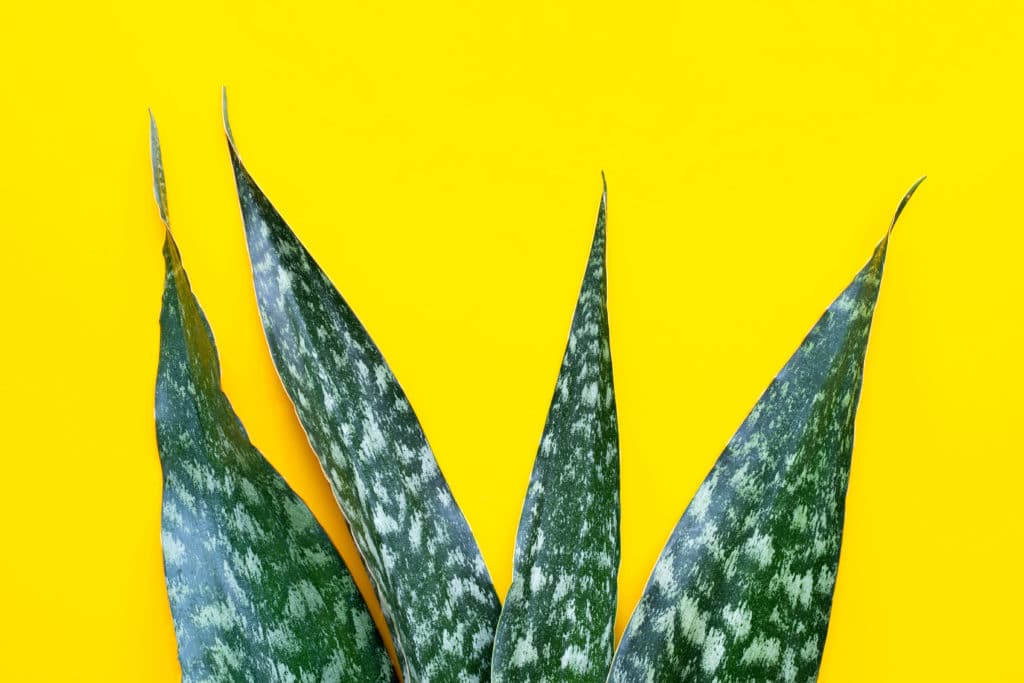
The Sansevieria Jaboa plant is a modern take on the snake plant. It is an easy-care indoor plant that doubles as a major sculptural element in any space.
The Jaboa plant gets its name from the Jaboa tree, which it resembles. For those of you unfamiliar with Jaboa trees, they are native to tropical regions and form thick stands along rivers and lakes. This type of environment makes them resistant to tough environmental conditions like flooding.
Unfortunately for us, this means we can’t grow Jaboa trees outside our homes (unless you live near water). Luckily for us, there is another option: the Sansevieria Jaboa plant.
The body of the plant is made up of many dark-green stiff and paddle-shaped leaves with greyish or sage-green spotted lines. These acute leaves may grow from 6 to 8 feet tall, depending on the situation.
It is suitable for both outdoor and indoor plantings since it has a wide range of light tolerance. The plant is an excellent choice for your home, place of business, and yards since it also has air-purifying qualities.
The sansevieria Jaboa plant is a perfect way to bring the outdoors in. With its tall, upright leaves and thick foliage, it makes a bold statement wherever you choose to place it.
So if you’re looking for an interesting and exotic plant that is tough as nails, the Jaboa plant is definitely worth considering!
Sansevieria Jaboa Classification
Family: Asparagaceae.
Genus: Dracaena (known as Sansevieria until 2017)
Species: D. trifasciata.
Cultivar: D. trifasciata ‘Jaboa’.
Sansevieria Jaboa Plant Features
Height:
Up to 96 in (240 cm).
Light Needs:
Bright light to full sun. Tolerates low light.
Watering Needs:
Keep soil moderately moist, but do not overwater. Let the top inch of soil dry out between waterings.
Soil Type:
Well-draining potting mix.
Fertilizer:
Feed with a high-phosphorus fertilizer every other month when actively growing.
Pests and Diseases:
Mealybugs, scale insects, spider mites, and root rot are all possible problems. Sansevieria Jaboa plants are generally very resistant to pests and diseases though.
Toxicity:
The toxic nature of the Jaboa Mother-in-law’s tongue is comparable to that of other Senseviera species. Vomiting, nausea, and diarrhea can be caused by ingestion. As a result, keep your children and pets away from this shrub. Also, if you eat any of it, make sure to get emergency medical care right away.
Air-purification:
Jaboa and its parent plant are on NASA’s list of air-purifying plants, which eliminate noxious pollutants such as formaldehyde and benzene derivatives from the environment. They remove harmful contaminants from the air, such as formaldehyde and benzene derivatives. This is an excellent choice for houses or offices where they clean your surrounding air.
How to Care for Sansevieria Jaboa Plants
Light:
The Jaboa plant loves bright light and tolerates low light well too! The more sun your Jaboa gets, the more often it will need water though. Although this may sound counter-intuitive since we think that plants in direct sunlight get their moisture from rain or irrigation systems. However, because of the large size of these leaves, they actually lose a lot through evaporation. That’s also why you should always put your Jaboa in a location where its leaves don’t touch curtains or blinds as these surfaces can cause serious leaf burn if exposed to even indirect sunlight. In fact, if you live in an area with intense sunlight, it might be best to grow your Jaboa indoors.
Water:
Keep the soil moist but not wet by watering when the top inch of soil feels dry to the touch. Overwatering can lead to root rot, so make sure to only water when necessary. You may need to water more frequently during periods of high growth or summer months.
Temperature:
The Jaboa snake plant is a hardy succulent that does well in a wide range of temperatures, from 50-90 degrees Fahrenheit (-15 – 32 degrees Celsius). However, it will stop growing at lower temps and may even go dormant at cooler temps.
Soil:
A well-draining potting mix is essential for Jaboa plants. Make sure to use soil that is specifically made for cactus and succulents, or you can create your own by mixing one part peat moss to two parts sand or perlite.
Fertilizer:
Feed your Jaboa plant with a high-phosphorus fertilizer every other month when it’s actively growing. This will help promote healthy growth and lush foliage.
How to Propagate Sansevieria Jaboa Plants
If you want to propagate Jaboa plants, you can easily do so from a cutting. Simply snip off a section of the plant that has at least one or two sets of leaves and let it air dry for about an hour to make sure no water remains on its surface. After this initial drying period, remove any excess soil around the roots with your fingers before planting in succulent potting mix.
Water Sansevieria Jaboa plants sparingly as they are slow-growing plants but don’t overwater! Healthy Jaboa plants have plump green foliage. Leaves will droop when thirsty and shrivel up if too much water is applied! Proper care ensures healthy growth which leads to more flowers blooming each season throughout their life cycle!
Propagation by Stem-cuttings:
This is the most simple and quickest method.
- Take a sterile instrument and cut a few healthy leaves from the plant.
- In damp, well-draining soil, put these leaves about three inches deep.
- Place the system in indirect light. Right after the soil has been watered, it should be fully dry (about 80 percent).
- Wait a few weeks before you can plant it out in the ground. You should wait approximately a month before seeing tiny shoots emerge from the base of the leaf. This young plant will take about three months to become a little ornamental plant. After that, all you have to do is follow the Care instructions given in the previous section.
You may also chop the leaves into a few pieces and put them in soil. In addition, even laying them on damp growing medium-light sphagnum moss is sufficient. 3 weeks later, these fragments will form tiny roots before producing baby branches. After they develop the stems, you may finally plant them directly (about 3 inches deep) in the earth to allow them to flourish.
